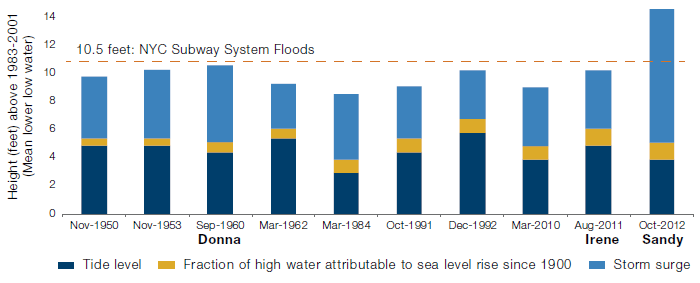Hurricane Sandy was a major wake-up call when it came to bringing to light New York City’s resilience against climate change.
Hurricane Sandy was a major wake-up call when it came to bringing to light New York City’s resilience against climate change.
December 2019
A “raging freak of nature” is how the National Geographic described Hurricane Sandy when it made landfall in 2012.
Indeed, Sandy was one of the costliest storms in the US, causing at least USD70 billion in damages in the US, and about USD19 billion in New York City alone.
Figure 1: Five Costliest US Hurricanes
Source: NOAA1.
Hurricane Sandy was a major wake-up call when it came to bringing to light the city’s resilience against climate change, according to Lolita Jackson, Special Advisor to the Senior Director of Climate Policy and Programs at the New Yok City Office of the Mayor.
“We are an island city – we have 520 miles of coastline and only one of the five boroughs, the Bronx, is connected to the mainland. In addition, a lot of our public housing is built on the waterfront at Coney Island and the Rockaways,” Jackson said in a podcast hosted by Jason Mitchell, co-head of responsible investment at Man Group. “New York city’s unique geography means that a managed retreat is not an option when confronting extreme weather events. So our planning processes need to make sure that we protect these areas, not only in the present, but also in the future.”
Beyond the headline cost, Sandy also raised issues of preparedness. For instance, about half of New York City’s food supplies enter the city via Hunts Point Market in the Bronx. Had the facility been flooded, food supplies to the city would have been severely disrupted. Additionally, the main mail facilities in Manhattan were flooded during the storm, preventing those on public assistance from receiving monthly cheques.
Figure 2: In Numbers – Sandy’s Impact on New York City
Source: Sandy and Its Impacts.
Figure 3: High-Water Levels in Lower Manhattan

Source: Sandy and Its Impacts.
In response, the city has focused on increasing its resilience in a way which takes account of issues of climate justice, especially in terms of inequality. Under Mayor Michael Bloomberg in 2007, the focus was on the growth and sustainability of New York City. In 2011, the focus shifted more to the sustainability component. In 2013, the emphasis was on building and resiliency. In 2015, under Mayor Bill de Blasio, attention also shifted to the social effects of what make a city resilient.
“A significant portion of New York City residents – 45% – live at or near poverty. So, if you want to solve the climate issues, you have to involve the people that are being affected by them,” Jackson said in the podcast. “When you ignore those communities or you don’t have them involved in the planning process, then you’re really not planning for a resilient or climate-friendly future.”
Comments may have been edited and condensed for editorial purposes.
1. https://coast.noaa.gov/states/fast-facts/hurricane-costs.html
You are now exiting our website
Please be aware that you are now exiting the Man Institute | Man Group website. Links to our social media pages are provided only as a reference and courtesy to our users. Man Institute | Man Group has no control over such pages, does not recommend or endorse any opinions or non-Man Institute | Man Group related information or content of such sites and makes no warranties as to their content. Man Institute | Man Group assumes no liability for non Man Institute | Man Group related information contained in social media pages. Please note that the social media sites may have different terms of use, privacy and/or security policy from Man Institute | Man Group.